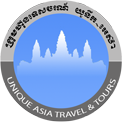West Baray
|
What is the largest and the most voluminous of all Khmer constructions? No, Angkor Wat is only number 3 or 4 in this hitlist of superlatives. Number 2 is the East Baray dam. But the biggest Khmer stuff is the West Baray. Looking on this dam today is not as overwhelming as seeing the Angkor Wat. Nevertheless, be aware, this was by far the largest artificial lake of mankind outside China. And the two Baray reservoirs were the reason why so many people could live in the plains of Angkor and work for an empire that was able to build the Angkor Wat.
The West Baray, like all reservoirs in Angkor, is oriented east-west. It is located west of Angkor Thom. The city walls of the first Angkor capital, Yashodharapura, were integrated as the northern part of the Baray's eastern dyke. The West Baray is a perfect rectangle, measuring approximately 8 km by 2 km. Originally it had an average depth of 7 metres, holding 120 million cubic litres of water. Most probably the construction work for this second giant reservoir of Angkor was already begun under the rule of of King Suryavarman I, who, besides Angkor Wat builder Suryavarman II and Angkor Thom founder Jayavarman VII later on, was one of the three most powerful and long reigning Khmer emperors. But the enormous construction was finalized under King Udayadityavarman II (1050-66), who also completed the Baphuon, Angkor's largest temple in the eleventh century. The West Baray submerged earlier buildings, the southern dam partially buried the first Khmer pyramid, Ak Yum. The western part of the Baray covers large areas of an earlier settlement. Early archaeologists believed the West Baray was a vast functional building allowing multiple crops of rice each year. Others claimed quite the contrary, that the whole monument was mainly sacred, an earthly symbol of the Sea of Creation according to Hindu believes, with the Mebon island temple as its sanctuary. The reason for this theory, once supported by the renowned anthropologist and Maya-expert Michael Coe, is that until now no apparatus for carrying off the water to the paddy fields was discovered. On the other hand, new research emphasized the interdependence of Baray waterlevels and Angkor's heydays throughout five centuries. Maybe the construction of the second giant reservoir was due to first problems with holding the water levels high enough in the East Baray. And satellite imagery helped to discover the existence of distribution channels. But even if they should have been functional reservoirs for irrigation, there can be no doubt, Barays served as religious monuments, too. Most probably water or flooding or harvest festivals were celebrated here. And throughout the whole Angkor era there was an intimate ideological association between king and baray as providers of fertility and welfare. A new concrete irrigation lock was built in the baray's southern dam, it allows regulating the water level and irrigation of farmland to the south. This is why the West Baray retains water in its western part year-round. Only during the rainy season, water sometimes advances to the eastern dike, but the eastern part remains more a marshland and paddy area than a lake. The reservoir today is a popular place for leisure, picnics and boat trips. Locals from Siem Reap like to spend an offday here. Touristic itineraries for foreigners in Angkor usually do not include a visit of the West Baray. But for those having spent enough time at the touristic highlights, a mountainbike or motorbike tour along the dam and to the typical Khmer villagelife and some small temples in the vicinity is recommendable, for a change. For historians, archaeologists or anthropologists the West Baray is a must-see, of course. Morning and late afternoon hours are nice at the West Baray. A ticket is not required here. |
